2016 NEWS & ANNOUNCEMENTS
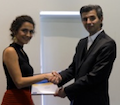 Nov. 22, 2016 • ACADEMIC ACHIEVEMENT AWARDS • Photo album of the Academic Achievement Awards Ceremony honouring undergraduate and graduate student academic excellence. The ceremony was held at the Mattamy Athletic Center on Nov. 17.
Nov. 22, 2016 • ACADEMIC ACHIEVEMENT AWARDS • Photo album of the Academic Achievement Awards Ceremony honouring undergraduate and graduate student academic excellence. The ceremony was held at the Mattamy Athletic Center on Nov. 17.
 Nov 10, 2016 • FUNDING FOR WIRELESS SENSING AND TRACKING IN MINES • Dr. Xavier Fernando's team has received $400,000 from Ontario Centers of Excellence and NSERC for their research project "Wireless Sensing and Tracking in Harsh, Low-Light Underground Mines" under the SOSCIP Smart Computing R&D Challenge program.
Nov 10, 2016 • FUNDING FOR WIRELESS SENSING AND TRACKING IN MINES • Dr. Xavier Fernando's team has received $400,000 from Ontario Centers of Excellence and NSERC for their research project "Wireless Sensing and Tracking in Harsh, Low-Light Underground Mines" under the SOSCIP Smart Computing R&D Challenge program.
This project proposes to significantly improve safety, communications, tracking, and monitoring solutions for personnel, vehicles, and explosives in mines in collaboration with PBE Canada, a world leader in mine safety equipment. In addition to improving the workplace safety of miners, outcomes will also boost productivity by reducing downtime.
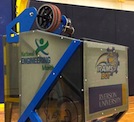 Nov 2, 2016 • RAMSBOT • RamsBot (The Eyeopener) is a mobile wheeled robot designed to play basketball and shoot three-pointers. It was built by Ryerson Rams Robotics Team, R3, captained by Michael Marmeto, a fourth-year electrical engineering student.
Nov 2, 2016 • RAMSBOT • RamsBot (The Eyeopener) is a mobile wheeled robot designed to play basketball and shoot three-pointers. It was built by Ryerson Rams Robotics Team, R3, captained by Michael Marmeto, a fourth-year electrical engineering student.
In January 2015, R3 was approached by the FEAS office with the project proposal. Michael Marmeto, Jahiz Ahmed, Feroz Barlsara and Eric Furtado designed and built RamsBot over the course of six weeks.
"RamsBot started out as a centerpiece for the celebration of National Engineering Month, promoting science, technology, engineering and mathematics (STEM) to the public. It was designed to try and foster public interest in in engineering", said Feroz Balsara, co-captain of R3 and fourth-year mechanical engineering student specializing in mechatronics.
 Oct 31, 2016 • IEEE AWARD • Xavier Fernando received an award for sustained long-term leadership and support of the IEEE Toronto Section and its conferences, during the Section AGM on October 29, 2016.
Oct 31, 2016 • IEEE AWARD • Xavier Fernando received an award for sustained long-term leadership and support of the IEEE Toronto Section and its conferences, during the Section AGM on October 29, 2016.
 Oct 27, 2016 • $40K OCE AWARD • Xavier Fernando was awarded an Ontario Centres of Excellence's (OCE's) Voucher for Innovation and Productivity (VIP) award for $20,000.
Oct 27, 2016 • $40K OCE AWARD • Xavier Fernando was awarded an Ontario Centres of Excellence's (OCE's) Voucher for Innovation and Productivity (VIP) award for $20,000.
Contributions from Nautic Devices Inc in the amounts of $5,000 cash and $15,280 in-kind for the project titled, "Enhancement of Full Duplex Wireless Transceivers."
 Oct. 24, 2016 • INTERNATIONAL SYMPOSIUM ON MICROGRIDS • Amir Yazdani chaired the International Symposium on Microgrids in Niagara-on-the-Lake, on October 20 and 21, 2016.
Oct. 24, 2016 • INTERNATIONAL SYMPOSIUM ON MICROGRIDS • Amir Yazdani chaired the International Symposium on Microgrids in Niagara-on-the-Lake, on October 20 and 21, 2016.
It was the twelfth event of the series of Symposium on Microgrids and hosted presentations, panels, and posters delivered by internationally-recognized experts in the area of microgrids from academia, industry, and governments. The Symposium was sponsored by Ryerson University, Lawrence Berkeley National Lab, and 13 notable Canadian and American corporations in the field of electric power systems and microgrids. The following Ryersonians were members of its Local Organising Committee: Amir Yazdani (Chair), Dimitri Androutsos, David Begg, and Nikoo Kouchakipour.
The previous 11 events were held in Berkeley, USA (2005), Montreal, Canada (2006), Nagoya, Japan (2007), Kythnos Island, Greece (2008), San Diego, USA (2009), Vancouver, Canada (2010), Jeju Island, Korea (2011), Evora, Portugal (2012), Santiago, Chile (2013), Tianjin, China (2014), and Aalborg, Denmark (2015).
 Oct. 24, 2016 • GOVERNOR GENERAL GOLD MEDAL • Bin Wu's Ph.D. graduate, Dr. Sebastian Rivera Iunnissi, was awarded the 2016 Governor General's Gold Medal at the Convocation ceremony on Wednesday Oct. 19.
Oct. 24, 2016 • GOVERNOR GENERAL GOLD MEDAL • Bin Wu's Ph.D. graduate, Dr. Sebastian Rivera Iunnissi, was awarded the 2016 Governor General's Gold Medal at the Convocation ceremony on Wednesday Oct. 19.
 Oct. 14, 2016 • $575K NSERC STRATEGIC PARTNERSHIP GRANT • Lian Zhao and her collaborators at the University of Victoria and the University of Waterloo were awarded a 2016 NSERC Strategic Partnership Grant for Projects (STPGP).
Oct. 14, 2016 • $575K NSERC STRATEGIC PARTNERSHIP GRANT • Lian Zhao and her collaborators at the University of Victoria and the University of Waterloo were awarded a 2016 NSERC Strategic Partnership Grant for Projects (STPGP).
The proposal, entitled "MOST- Network EVs for Green Intelligent Transportation", is valued at $575K for 2016-2019. A total of 338 applications were received in the 2016 competition for Strategic Partnership Grants for Projects resulting in 83 award recommendations; a success rate of 24.6%.
 Sep 22, 2016 • IEEE BEST PAPER AWARD • Lian Zhao and Bobby Ma, together with their former Ph.D. student, Khalid Hafeez received the 2016 Best Land Transportation Paper Award from IEEE Vehicular Technology Society. The award was presented at IEEE Vehicular Technology Conference in Montreal, September 19-21, 2016.
Sep 22, 2016 • IEEE BEST PAPER AWARD • Lian Zhao and Bobby Ma, together with their former Ph.D. student, Khalid Hafeez received the 2016 Best Land Transportation Paper Award from IEEE Vehicular Technology Society. The award was presented at IEEE Vehicular Technology Conference in Montreal, September 19-21, 2016.
 Sep 13, 2016 • NEW BOOK • Lev Kirischian's book, "Reconfigurable Computing Systems Engineering: Virtualization of Computing Architecture" has been published by CRC Press.
Sep 13, 2016 • NEW BOOK • Lev Kirischian's book, "Reconfigurable Computing Systems Engineering: Virtualization of Computing Architecture" has been published by CRC Press.
The book describes the organization of reconfigurable computing system (RCS) architecture and discusses the pros and cons of different implementations providing a solid understanding of RCS technology and where it's most effective.
 Sep 8, 2016 • BEST PAPER AWARD • Farheen Khan and Andy Ye's paper, "An Evaluation on the Accuracy of the Minimum Width Transistor Area Models in Ranking the Actual Layout Area of FPGA Architectures," received the Michael Servit Best Paper Award at the 26th International Conference on Field-Programmable Logic and Applications (FPL'16), EPFL, Lausanne, Switzerland, August 29-September 2, 2016.
Sep 8, 2016 • BEST PAPER AWARD • Farheen Khan and Andy Ye's paper, "An Evaluation on the Accuracy of the Minimum Width Transistor Area Models in Ranking the Actual Layout Area of FPGA Architectures," received the Michael Servit Best Paper Award at the 26th International Conference on Field-Programmable Logic and Applications (FPL'16), EPFL, Lausanne, Switzerland, August 29-September 2, 2016.
 Sep 6, 2016 • NEW FACULTY • The Department welcomes Naimul Khan to the faculty. He has a co-appointment with the Department and the Masters of Digital Media program.
Sep 6, 2016 • NEW FACULTY • The Department welcomes Naimul Khan to the faculty. He has a co-appointment with the Department and the Masters of Digital Media program.
His research focuses on designing interactive methods for visual computing that can bridge the gap between end-users and systems. He has made contributions to the fields of machine learning, computer vision, and medical imaging.
 July 25, 2016 • TASME AWARD • Xavier Fernando was awarded the "TASME Award for Excellence in Wireless Communications" at the 20th annual TASME conference.
July 25, 2016 • TASME AWARD • Xavier Fernando was awarded the "TASME Award for Excellence in Wireless Communications" at the 20th annual TASME conference.
Elite Groups of scientists mathematicians, engineers and medical professionals from the public and private sectors annually conduct an international conference and share Technological Advances in Science, Medicine and Engineering (TASME) since 1996. The events have oral presentations from leading researchers as well as panel discussions and poster sessions. Please visit www.tasmeconferences.org/ and www.linkedin.com/groups/8401381 for more details.
 July 25, 2016 • Collaboration with Healthcare Management Systems • Xavier Fernando has initiated collaboration with Healthcare Management Systems and received an NSERC Engage Grant recently to develop algorithms for the accurate prognosis of impending health conditions of wearable medical device users, employing a cloud computing infrastructure.
July 25, 2016 • Collaboration with Healthcare Management Systems • Xavier Fernando has initiated collaboration with Healthcare Management Systems and received an NSERC Engage Grant recently to develop algorithms for the accurate prognosis of impending health conditions of wearable medical device users, employing a cloud computing infrastructure.
Recent advances in wireless and sensor technologies have been a vital driver for the widespread adaptation of wearable technology that is increasingly used to monitor various biomedical signals in real time. From simple heart rate monitors to advanced EKSO Bionics and OMSIGNAL smart shirts, numerous wearable devices are being introduced every day. According to market researchers, the wearable technology market to reach $70 billion by 2025 with 3 billion wearable sensors. Number of factors contributes this boost. Mainly, incorporation sensing and wireless communications technologies alongside new energy harvesting and storage techniques, efficient power management circuits and low power computing have resulted in form factors that are increasingly flexible, fashionable and invisible. These sensors are becoming more advanced in seamlessly collecting medical data about the consumers and be able to transmit it to nearby wireless access points. Rather than individually observing each sensor, this data has to be collectively stored and analyzed over a long period to make useful conclusions. However, with increased usage of the devices is also the amount of data. This massive amount of data needs to be appropriately fused and processed possibly using a cloud computing environment for developing algorithms for the accurate prognosis of impending health conditions. This will require accurate quantification risk factors and anomaly detection. Use of Rule based reasoning (RBR) models for early warning systems for fatal conditions such as heart attack or stroke attacks can be developed. This project will investigate statistical data analysis schemes, modeling and classification techniques in the presence of noisy and missing data. This project is expected to generate algorithms that will alarm and potentially save lives, reduce waiting time at emergency rooms and reduce healthcare costs.
 June 16, 2016 • ENGINEERING MEDAL FOR YOUNG ENGINEER • Ebrahim Bagheri has been awarded the 2016 Ontario Professional Engineers "Engineering Medal for Young Engineer" from the Professional Engineers of Ontario (PEO).
June 16, 2016 • ENGINEERING MEDAL FOR YOUNG ENGINEER • Ebrahim Bagheri has been awarded the 2016 Ontario Professional Engineers "Engineering Medal for Young Engineer" from the Professional Engineers of Ontario (PEO).
The Engineering Medal for Young Engineer recognizes outstanding engineers under the age of 35, who have made exceptional achievements in their chosen fields. This award is given to those who have demonstrated excellence not only in their engineering careers, but also in community and professional participation.
 June 2, 2016 • WIRELESS POWER • Xavier Fernando explains popularity of wireless charging for electric toothbrushes in May 28th issue of the Toronto Star.
June 2, 2016 • WIRELESS POWER • Xavier Fernando explains popularity of wireless charging for electric toothbrushes in May 28th issue of the Toronto Star.
"Wireless charging, as it turns out, is not most useful in cellphones. So far, it’s been most efficient for electric toothbrushes, says a Ryerson University professor. The reason it’s so effective in the bathroom may explain why it hasn’t caught on as hoped elsewhere. “The brush is always in the stand,” Xavier Fernando says as a way of explanation. Wireless charging radiates more energy than what actually reaches the device you’re powering up. The energy is lost in the air as it tries to find its way to, say, your cellphone. So it’s inefficient and the only way for it to be more efficient is for a device to sit in one spot, which defeats the purpose, Fernando says."
 May 30, 2016 • CMBES OUTSTANDING CANADIAN BIOMEDICAL ENGINEER AWARD • Sri Krishnan has been awarded the CMBES Outstanding Canadian Biomedical Engineer Award by the Canadian Medical & Biological Engineering Society. The award was presented at the annual conference in Calgary (CMBEC39 24-27 May).
May 30, 2016 • CMBES OUTSTANDING CANADIAN BIOMEDICAL ENGINEER AWARD • Sri Krishnan has been awarded the CMBES Outstanding Canadian Biomedical Engineer Award by the Canadian Medical & Biological Engineering Society. The award was presented at the annual conference in Calgary (CMBEC39 24-27 May).
This CMBES Award was established in 1989 and is presented to a Canadian biomedical engineer who has made outstanding contributions in the field of biomedical engineering. Such achievements can be in the form of scientific or technical developments as well as a broad-spectrum of areas such as leadership, service and organizational skills that contributed to the improvement of health care delivery in Canada, or prominence in organizations concerned with biomedical engineering at the national or international level. Achievements for consideration shall have taken place during the three years immediately preceding the award year.
 May 24, 2016 • GO GREEN COMPETITION •
Ryerson ECE team "Greengineer", comprised of Dewan Ahmed and Tithi Tasnuva— both Ryerson Electrical Engineering undergraduate students— reached the semi-finals of Go Green in the City competition for the North America region.
May 24, 2016 • GO GREEN COMPETITION •
Ryerson ECE team "Greengineer", comprised of Dewan Ahmed and Tithi Tasnuva— both Ryerson Electrical Engineering undergraduate students— reached the semi-finals of Go Green in the City competition for the North America region.
Go Green in the City is a global student competition for sustainable energy solutions hosted by Schneider Electric. More than 1500 teams participated this year and Ryerson fielded of the top 3 teams in Canada. They will be competing in phase 2 of the competition to reach the finals where only 12 teams worldwide will compete for the coveted crown.
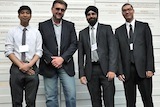
Marzio Pozzuoli Award ($10,000)
3D SCANNER
Bikramjeet Singh Pabla, Jamie Lee Huy, Jackie Nguyen. FLC: K. Raahemifar
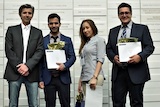
Dept. GOLD Capstone Award (each student received an Apple iPhone 6S)
TREMOR DATA-LOGGER FOR PARKINSON'S DISEASE PATIENTS
Shahin Khayyer, Sam Delavarkhan, Helia Azima. FLC: K. Umapathy
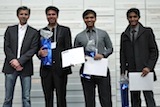
(TIE) Dept. SILVER Capstone Award (each student received an Apple Watch)
SMART HOME DASHBOARD FOR IOT
Amit K. Roy, Rajat Kumar Sikder, Omer Shukrullah. FLC: M. Kassam
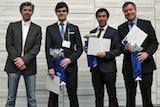
(TIE) Dept. SILVER Capstone Award (each student received an Apple Watch)
SMART MODEL TRAIN COMMUNICATION AND CONTROL SYSTEM
Sam LaBrier, Levon Khachatryan, Khai Trung Luu. FLC: M. Kassam
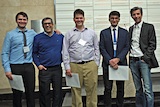
Dept. BRONZE Capstone Award (each student received an Apple TV box)
PIANOBOT (UNIVERSAL ELECTRONIC PIANO PLAYER)
Gentian Licenji, Sina Panahandeh, Brett Grady. FLC: M. Kassam
 May 5, 2016 • Victor Yang and 7D Surgical debut Envision 3D™ Image Guided Surgical Navigation
Envision 3D™ Image Guided Surgical Navigation system was unveiled to the world at the 84th AANS Annual Scientific Meeting.
May 5, 2016 • Victor Yang and 7D Surgical debut Envision 3D™ Image Guided Surgical Navigation
Envision 3D™ Image Guided Surgical Navigation system was unveiled to the world at the 84th AANS Annual Scientific Meeting.
Watch the introductory video of the product. For more information, please visit 7D Surgical.
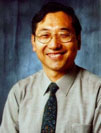 May 1, 2016 • LING GUAN GRANTS
May 1, 2016 • LING GUAN GRANTS
NSERC CRD: Cloud-based Multimodal Biometrics Framework for Road Safety
Amount: $450,000, 2016-2019.
PI: Ling Guan, Co-PI: Yifeng He
ORF-REP (Led by York University): Big Data Research, Analytics, and
Information Network (BRAIN) Alliance
Total Amount: $3,400,000, 2016-2020
Ryerson Amount: $500,000, 2016-2020
Ryerson Led: Ling Guan
 Mar 1, 2016 • $5M NSERC STRATEGIC PARTNERSHIP GRANT • Bala Venkatesh, director of Ryerson's Centre for Urban Energy (CUE), will lead a team of 27 professors from 15 universities and 8 provinces to create a more reliable, environmentally responsible and efficient power system.
Mar 1, 2016 • $5M NSERC STRATEGIC PARTNERSHIP GRANT • Bala Venkatesh, director of Ryerson's Centre for Urban Energy (CUE), will lead a team of 27 professors from 15 universities and 8 provinces to create a more reliable, environmentally responsible and efficient power system.  Feb 9, 2016 • TIER 2 CANADA RESEARCH CHAIR • Ebrahim Bagheri awarded a Tier 2 Canada Research Chair (CRC) in Software and Semantic Computing.
Feb 9, 2016 • TIER 2 CANADA RESEARCH CHAIR • Ebrahim Bagheri awarded a Tier 2 Canada Research Chair (CRC) in Software and Semantic Computing.
Dr. Bagheri is developing data analytics software methodologies and platforms that will help to understand and analyze the large volume of user-generated data created in recent years. Through his research, he wants to give software engineers and data scientists the tools and techniques they need to create software applications that can handle the demands of this growing industry.
 Mar 5, 2016 • NSERC ENGAGE GRANT • Muhammad Jaseemuddin has been awarded a NSERC Engage grant in collaboration with Innohub Inc. to develop a predictive system for web presentation logic through context-aware processing of user requests.
Mar 5, 2016 • NSERC ENGAGE GRANT • Muhammad Jaseemuddin has been awarded a NSERC Engage grant in collaboration with Innohub Inc. to develop a predictive system for web presentation logic through context-aware processing of user requests.